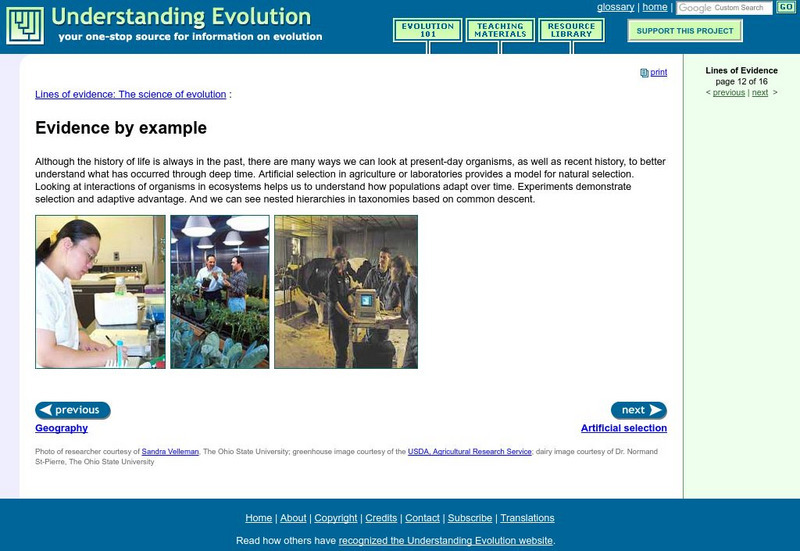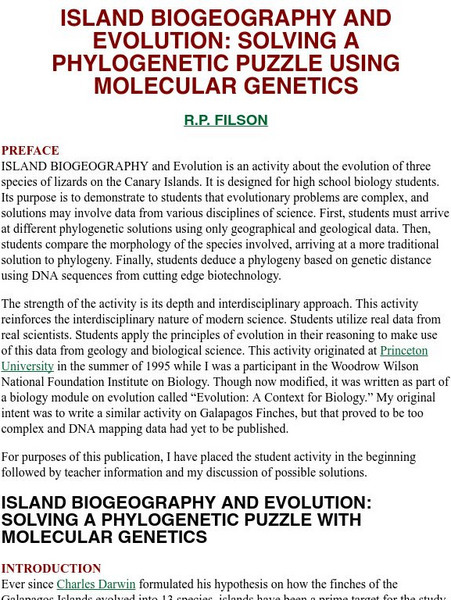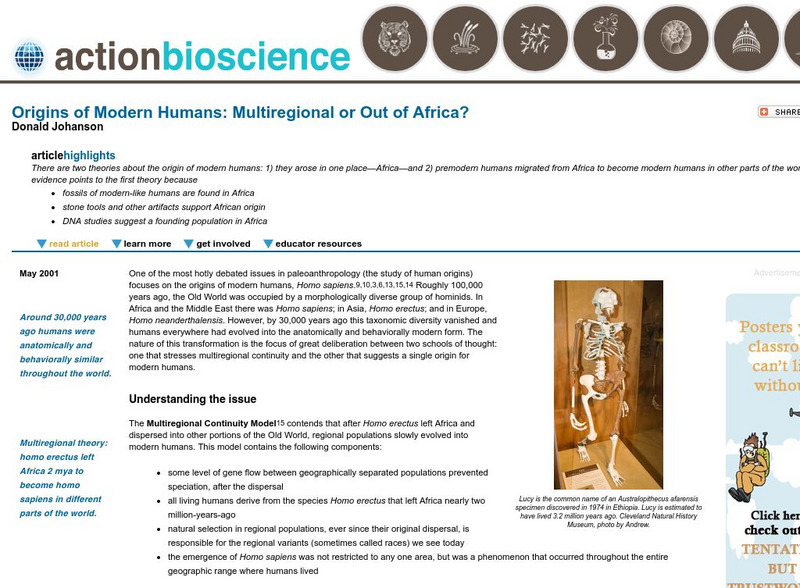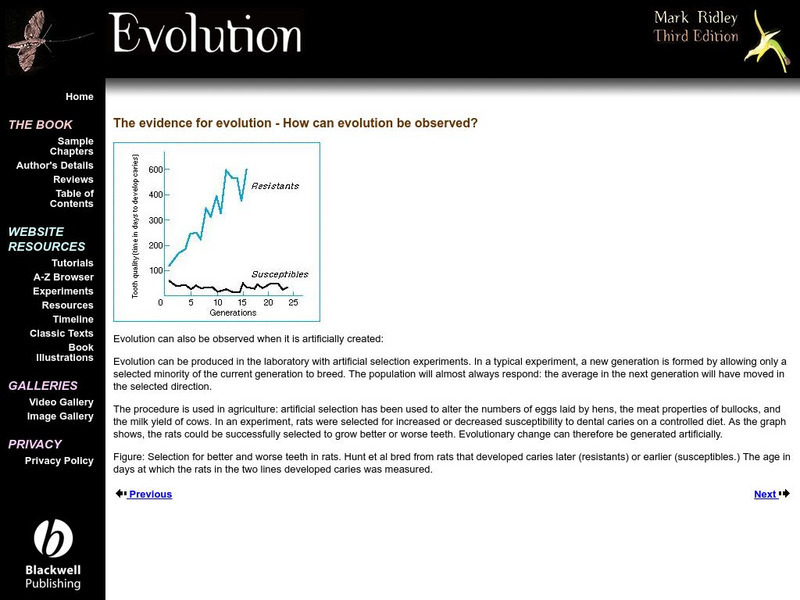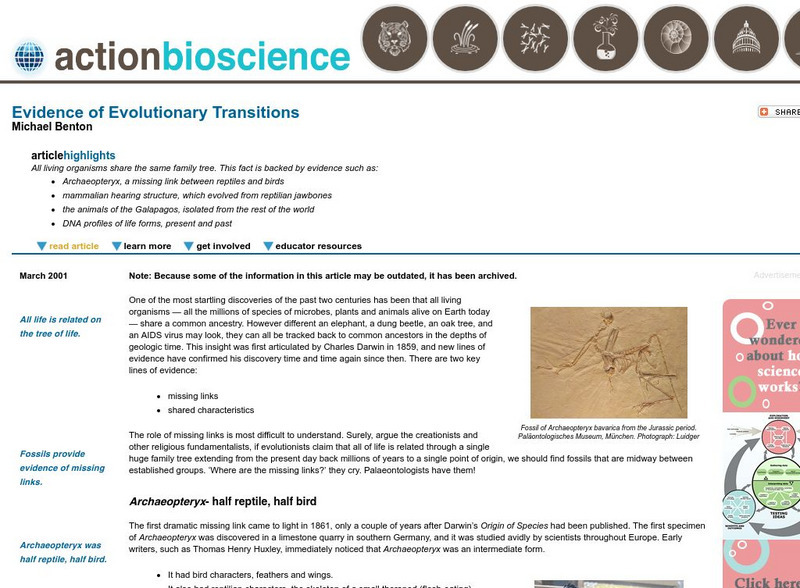Hi, what do you want to do?
University of California
University of California Museum of Paleontology: Evidence by Example
The Understanding Evolution website for teachers provides common examples of evolution, especially by artificial selection.
University of California
University of California Museum of Paleontology: Fossil Evidence
Understanding Evolution provides evidence for evolution using fossils. There are also links to lesson plans.
University of California
Ucmp: Island Biogeography and Evolution
This is a lesson designed by a biology teacher. In it, students use maps and evidence of island age, molecular genetics, morphology, and distance apart to determine how the islands came to be occupied by different species of lizards. It...
National Health Museum
Nhm: Amino Acid Sequences Show Evolution
This lesson plan focuses on differences in the amino acid sequence of hemoglobin and myoglobin proteins. They use the number of differences to create a phylogenetic tree.
BBC
Bbc: Gcse Bitesize: Evolution Aqa
Evolution is the change of inherited characteristics within a population over time through natural selection, which may result in the formation of a new species. Fossils provide a record of organisms that lived a long time ago. They also...
Other
Evidence for Evolution: Genetic Code
These pages are part of a site called Evolution that accompany a textbook by the same name. Mark Ridley is the author. In this section: the universal genetic code provides evidence that life has a common ancestor.
PBS
Pbs Learning Media: Nova Evolution Lab: Interactive Lesson: Mission 1
Explore the evidence of evolution with this interactive worksheet based off of NOVA's Evolution Lab. This resource is designed to be completed while playing through the Evolution Lab game and contains multiple choice and free response...
PBS
Nova: Intelligent Design on Trial: Fossil Evidence
The resource discusses fossil evidence of the intelligent design. The interactive activity explores five well-known fossil transitions that indicate Darwinian evolution in action. The activity consists of a printable version and...
PBS
Pbs Learning Media: Riddle of the Bones
At the online companion Web site of "Evolution," the seven-episode series on PBS, piece together clues to how one of our early ancestors looked as you examine images from four significant fossil finds of Australopithecus afarensis.
American Institute of Biological Sciences
Action Bioscience: Origins of Modern Humans: Multiregional or Out of Africa
Two migration theories are on the table for consideration. Weigh the evidence of each one in this article by Donald Johanson of Lucy fame.
Open Curriculum
Open Curriculum: Evolution Continues Today Can We Control It?
This article allows students to recognize that the process of evolution by natural selection continues to change our world and ourselves, both despite and because of our best efforts to control it.
National Health Museum
Access Excellence: Making a Phylogenetic Tree Lesson Plan
Constructing phylogenetic trees may be a daunting task for students, but this lesson plan is a simulation of what molecular biologists must do to determine relationships. This plan is for students who have a good grasp of DNA structure...
BioMan Biology
Bio Man Biology: Angry Aliens: Evolution
Teach aliens about evolution as you play this game, and review your own understanding in the process. Topics covered include evolutionary mechanisms, evidence of evolution, natural selection, reproductive isolation, population genetics,...
University of California
University of California Museum of Paleontology: Distribution in Time and Space
The Understanding Evolution site provides evidence for evolution in biogeography utilizing relative dating, geography, and plate tectonics.
Bryn Mawr College
Bryn Mawr College: Evolution, Ecology, Diversity: Evolution by Natural Selection
After looking at examples of natural selection and doing a simulation activity, young scholars investigate further by playing a simulation game and analyzing the data they collect. They then examine evidence of natural selection for the...
University of California
University of California Museum of Paleontology: Homologies
These pages are from the Understanding Evolution website for teachers. They focus on homologous structures that organisms with common ancestors share.
Other
Evidence for Evolution: How Can Evolution Be Observed?
These pages are part of a site called Evolution that accompanies a textbook by the same name. Mark Ridley is the author. In this section, he describes how artificial selection has provided many examples of evolutionary change. Examples...
CPALMS
Florida State University Cpalms: Florida Students: Evolution: Examining the Evidence
Strengthen understanding of how different types of scientific evidence support the theory of evolution, including direct observation, fossils, DNA, biogeography, and comparative anatomy and embryology.
Other
E Fossils: Step by Step: Evolution of Bipedalism
In this tutorial, students will identify the fossil evidence for the evolution of bipedalism then hypothesize about the evolutionary pressures affecting bipedal behavior.
PBS
Pbs: Intimate Strangers: Tree of Life
Find out how Dr. Carl Woese used RNA to develop the tree of life.
PBS
Pbs Learning Media: Darwin's Diary
At the online companion Web site of "Evolution," the seven-episode series on PBS, delve into the private thoughts of a reluctant revolutionary--Charles Darwin.
University of California
University of California Museum of Paleontology: Stories From the Fossil Record
This colorful, interactive site demonstrates how fossils can be used to discover a range of information about the past. Topics include Past Lives, Paleoecology, Geologic History, and Biodiversity.
Other
The Evidence for Evolution: Biogeography
These pages are part of a site called "Evolution," that accompanies a textbook by the same name. Mark Ridley is the author. These pages are about the house sparrow and the differences that can be observed in it in different geographical...
American Institute of Biological Sciences
Action Bioscience: Evidence of Evolutionary Transitions
Charles Darwin's theory that all living organisms are connected in some way has been confirmed through intense studies over centuries. Understand the similarities that bond all things living to the same family tree by checking out this...





